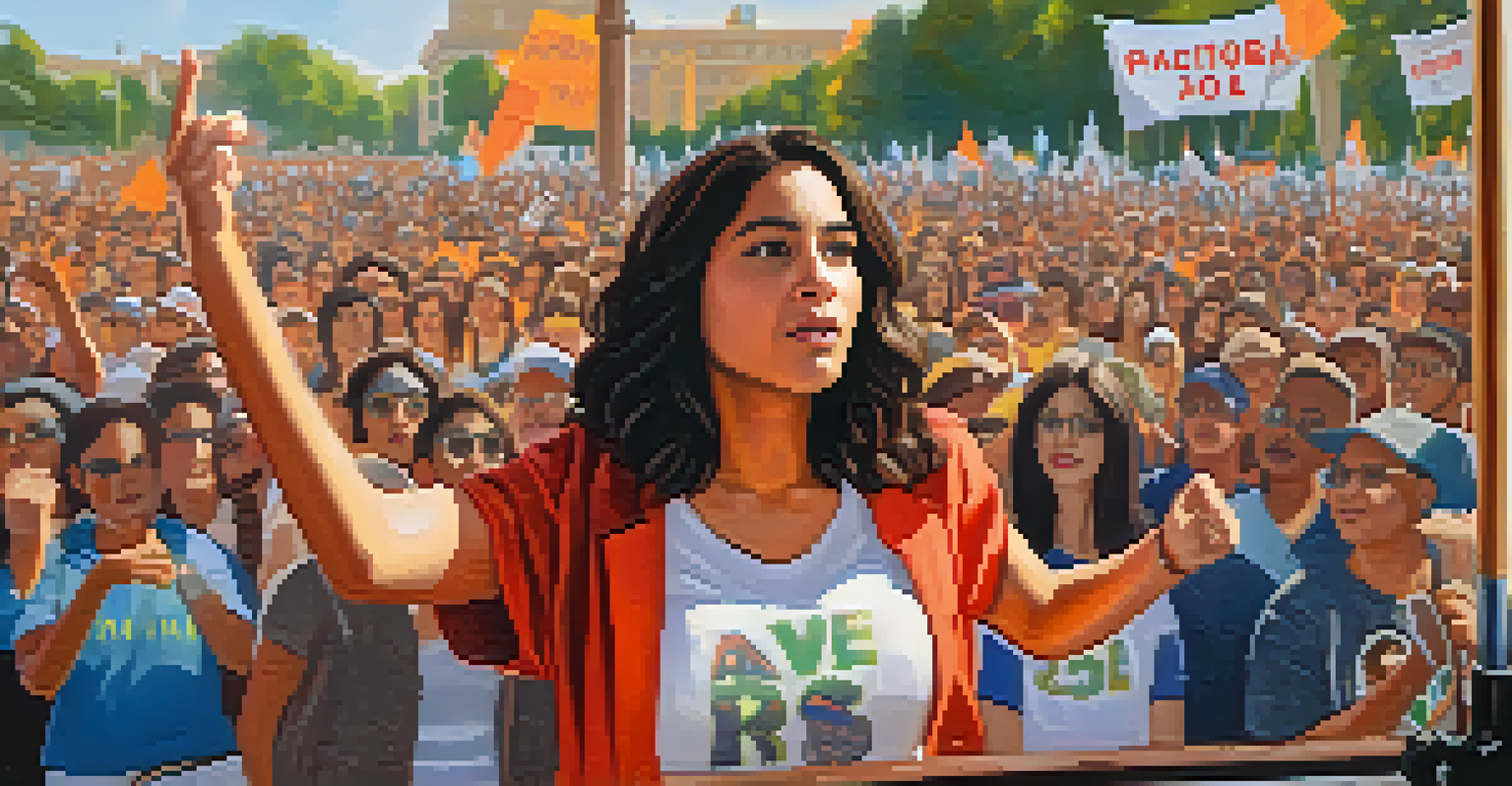The Rise of Youth Activism in Compton: A Historical Overview

Understanding the Roots of Youth Activism in Compton
Youth activism in Compton has deep historical roots, stemming from the civil rights movement of the 1960s. Young people, fueled by the injustices they witnessed, began organizing to demand equal rights and opportunities. This period marked the beginning of a legacy that empowered future generations to speak out against systemic issues in their community.
Injustice anywhere is a threat to justice everywhere.
As the civil rights movement gained momentum, Compton's youth became increasingly inspired by figures like Angela Davis and the Black Panther Party. These activists advocated for social justice and community empowerment, igniting a spark among local youth. Their efforts laid the groundwork for a culture of activism that would resonate for decades to come.
Today, understanding this historical context is crucial to appreciating the vibrant activism we see in Compton. It highlights how past struggles have shaped the present, encouraging today's youth to continue the fight for justice and equality.
Key Events That Shaped Youth Activism in Compton
Throughout the years, several pivotal events have propelled youth activism in Compton. One significant moment was the 1992 Los Angeles riots, which prompted a wave of anger and frustration among young people in the area. This unrest galvanized many to take action, leading to increased political engagement and community organizing.

In the years following the riots, local youth began establishing organizations focused on social change, such as the Compton Youth Program. These initiatives provided a platform for young activists to voice their concerns and advocate for issues like education reform, police accountability, and economic opportunities. Such grassroots movements were crucial in mobilizing the community and amplifying their voices.
Historical Roots of Activism
Youth activism in Compton has deep historical roots dating back to the civil rights movement, inspiring generations to fight for justice.
These events underscore the resilience of Compton’s youth and their ability to adapt to changing circumstances. Each incident served as a catalyst for further activism, illustrating how collective experiences can shape a community's response to adversity.
The Role of Education in Fostering Activism
Education has always played a vital role in youth activism, serving both as a tool for empowerment and a platform for advocacy. In Compton, schools have become spaces where young people learn about their rights and the importance of civic engagement. This knowledge empowers them to challenge the status quo and demand change.
Art is the most beautiful of all lies; it is the most beautiful evidence of the spirit of a people.
Programs like the Youth Leadership Academy have been instrumental in providing students with the skills they need to become effective advocates. Workshops on public speaking, organizing, and policy-making equip young activists to articulate their visions for a better community. By fostering these skills, educators help cultivate the next generation of leaders.
Moreover, the collaboration between schools and local organizations has created a supportive environment for activism. When young people are encouraged to engage with their communities, they not only gain valuable experience but also foster a sense of responsibility towards social change.
Social Media: A New Frontier for Youth Activism
In the digital age, social media has transformed the landscape of activism, allowing youth in Compton to connect and mobilize like never before. Platforms like Instagram and Twitter have become powerful tools for raising awareness about social issues, enabling young activists to share their stories and rally support. This shift has made activism more accessible and immediate.
For instance, local campaigns addressing police brutality and educational disparities have gained traction online, reaching audiences far beyond Compton. Hashtags like #ComptonYouthRise have sparked conversations and inspired solidarity among youth across the nation. This illustrates how digital platforms can amplify local voices and create a broader movement.
The Power of Education
Education plays a pivotal role in empowering Compton's youth by equipping them with the skills needed for effective advocacy.
However, while social media offers significant advantages, it also presents challenges, such as misinformation and the fleeting nature of online attention. Nevertheless, Compton's youth continue to harness these platforms to initiate meaningful dialogue and drive change in their community.
Prominent Youth Activists Leading the Charge
Compton is home to many inspiring youth activists who are making waves both locally and nationally. Leaders like 18-year-old activist and speaker, Maria Gonzalez, have emerged as vocal advocates for education reform and community safety. Their dedication and passion serve as a beacon of hope for their peers and have garnered attention from media and policymakers alike.
These young leaders often draw on their personal experiences to connect with others and inspire action. By sharing their stories of resilience and determination, they motivate their peers to join the fight for social justice. This personal connection not only strengthens the movement but also fosters a sense of community among activists.
As these young individuals continue to rise, they remind us of the power of youth voices. Their influence extends beyond Compton, encouraging other young people to stand up and advocate for the changes they wish to see in their own communities.
The Intersection of Art and Activism in Compton
Art has long been a powerful medium for activism, and in Compton, it plays a crucial role in expressing the struggles and aspirations of youth. Murals, music, and performance art serve as forms of protest and storytelling, making complex issues more relatable and engaging. These artistic expressions often capture the spirit of resilience that defines the community.
For example, local artists use their craft to address themes of social justice, identity, and empowerment. Projects like the Compton Art Walk not only showcase local talent but also create spaces for dialogue around pressing issues. This blending of art and activism fosters a sense of unity and encourages community members to engage in conversations about change.
Art as a Tool for Change
Art in Compton serves as a powerful medium for activism, allowing youth to express struggles and inspire community engagement.
By intertwining creativity with advocacy, Compton's youth can reach a wider audience and inspire action. This intersection not only enriches the cultural landscape but also reinforces the importance of art as a vehicle for social change.
Looking to the Future: Sustaining Youth Activism
As we look to the future, sustaining youth activism in Compton is vital for continued progress. Building strong networks and mentorship programs can provide young activists with the support they need to thrive. Encouraging intergenerational dialogue allows experienced activists to share wisdom and strategies with the younger generation.
Moreover, fostering partnerships between youth organizations and local governments can help bridge the gap between activism and policy change. By creating avenues for young people to engage in decision-making processes, their voices can be integrated into the fabric of local governance. This not only empowers youth but also ensures their concerns are addressed.

Ultimately, the legacy of youth activism in Compton depends on collective efforts to nurture and sustain this spirit of activism. By investing in the next generation, we can ensure that the fight for justice and equality continues, building a brighter future for all.